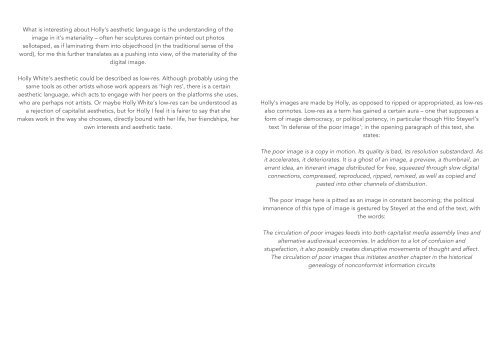The$Aesthe(cs$of$Exhibi(onism$ - Arcadia Missa
The$Aesthe(cs$of$Exhibi(onism$ - Arcadia Missa
The$Aesthe(cs$of$Exhibi(onism$ - Arcadia Missa
You also want an ePaper? Increase the reach of your titles
YUMPU automatically turns print PDFs into web optimized ePapers that Google loves.
What is interesting about Holly’s aesthetic language is the understanding of the<br />
image in it’s materiality – often her sculptures contain printed out photos<br />
sellotaped, as if laminating them into objecthood (in the traditional sense of the<br />
word), for me this further translates as a pushing into view, of the materiality of the<br />
digital image.<br />
Holly White’s aesthetic could be described as low-res. Although probably using the<br />
same tools as other artists whose work appears as ‘high res’, there is a certain<br />
aesthetic language, which acts to engage with her peers on the platforms she uses,<br />
who are perhaps not artists. Or maybe Holly White’s low-res can be understood as<br />
a rejection of capitalist aesthetics, but for Holly I feel it is fairer to say that she<br />
makes work in the way she chooses, directly bound with her life, her friendships, her<br />
own interests and aesthetic taste.<br />
Holly’s images are made by Holly, as opposed to ripped or appropriated, as low-res<br />
also connotes. Low-res as a term has gained a certain aura – one that supposes a<br />
form of image democracy, or political potency, in particular though Hito Steyerl’s<br />
text ‘In defense of the poor image’; in the opening paragraph of this text, she<br />
states:<br />
The poor image is a copy in motion. Its quality is bad, its resolution substandard. As<br />
it accelerates, it deteriorates. It is a ghost of an image, a preview, a thumbnail, an<br />
errant idea, an itinerant image distributed for free, squeezed through slow digital<br />
connections, compressed, reproduced, ripped, remixed, as well as copied and<br />
pasted into other channels of distribution.<br />
The poor image here is pitted as an image in constant becoming; the political<br />
immanence of this type of image is gestured by Steyerl at the end of the text, with<br />
the words:<br />
The circulation of poor images feeds into both capitalist media assembly lines and<br />
alternative audiovisual economies. In addition to a lot of confusion and<br />
stupefaction, it also possibly creates disruptive movements of thought and affect.<br />
The circulation of poor images thus initiates another chapter in the historical<br />
genealogy of nonconformist information circuits


